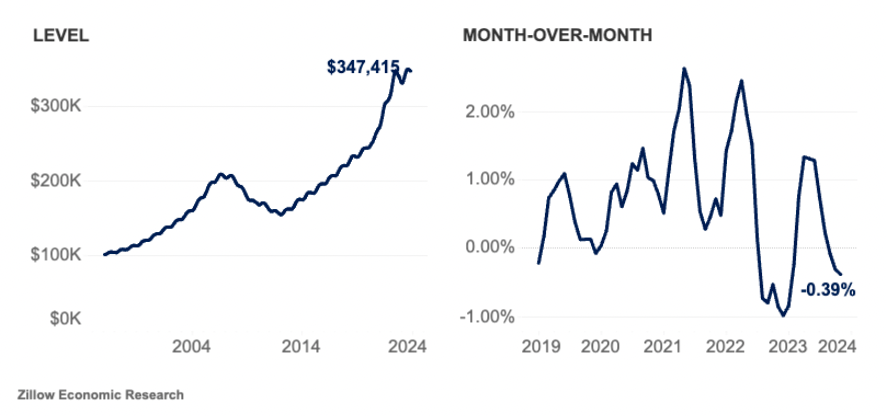Mortgage rates are falling from a 23-year high, offering some relief for home shoppers and sellers nationwide, according to Zillow's November 2023 Housing Market Report. The analysis shows monthly costs for a new mortgage are declining, inventory is trending back toward normal, and price cuts are becoming more common.
"Despite high-cost headwinds, buyers have a few things to be thankful for in today's market," said Skylar Olsen, Chief Economist at Zillow. "Home prices are cooling down faster than normal as new listings from existing owners and total inventory slowly recover. Mortgage rates are still above 7%, but price cuts are surprisingly common, and mortgage costs have eased a bit. These factors favor buyers who are reluctant to pause their home search in the off-season."
Key Findings:
- Monthly mortgage payments on a home purchase fell about 1.5% from October to November.
- Rate locks may be easing as a two-year new-listings shortfall shrank to 14.1% below "normal."
- Typical home values fell 0.4% month over month, slightly faster than typical for this time of year.

Mortgage costs tick down, along with rates and home values.
Homebuyers facing extreme cost challenges received a bit of relief as monthly mortgage costs on a typical home purchase fell 1.5% from October to November. That's down from a peak in October, when costs were up 9% annually and almost 120% above pre-pandemic levels.
Affordability improved, too, with mortgage payments, as a share of household income, falling from October's record high of 40.4% to 38.6% in November.
The monthly decline in costs was primarily driven by falling mortgage rates. But rates still higher than 7% also helped push down home values.
The Zillow Home Value Index declined 0.4% from October to November, falling slightly faster than what was previously considered "normal" for this time of year. Still, the typical national home value is up 2.8% from last year and now stands at $347,415.
Annual growth is strongest in Hartford, CT (11.3%), Milwaukee (8.5%), and San Diego (7.6%), places where demand has overwhelmed supply. The largest annual drops were in New Orleans (-8.9%), Austin, Texas (-8.2%), and San Antonio (-3%), with those last two metros serving as examples of how a surge in new construction is helping rebalance markets.
Inventory continues to climb out of the pandemic hole.
Home shoppers have dealt with a low flow of new listings for nearly two years, but some sellers are finally returning to the market. New listings bottomed out at almost 35% below pre-pandemic norms in April, but positive momentum over the past few months has cut the shortfall to just 14%. Still, new listings fell 20.5% month over month—a much smaller drop than normal for November.
Mortgage rates slightly down from an October peak, or an expectation for relatively high rates for longer, may be shaking some current owners free from "rate lock." Metros in the Midwest, the Great Lakes region, and the South have the smallest declines in new listings compared to before the pandemic. Zillow surveys show 70% of sellers are also buying; relative affordability in these areas offers inbound movers an easier time.
Total inventory continues to slowly recover from its pandemic deficit but remains down 37.2%.
Price cuts are still abnormally common as sellers respond to high rates.
Sellers are responding to affordability challenges by cutting list prices. The share of listings that saw a price cut in November is unseasonably high at 22.6%—even more so than October's rate of 25%. Agents are updating pricing strategies as persistently high mortgage rates weigh on homebuyers. Moving into winter, there's a good chance homebuyers will have more wiggle room in negotiations.
Price cuts are most common in Tampa (33%), Indianapolis (31.7%), Salt Lake City (30.8%), and Nashville (30.5%).
Rents fell, but remain in line with seasonal norms.
Asking rents across the U.S. ticked down in November at roughly the level we expect to see this time of year based on historic norms. Rent growth for single-family homes has been stronger than for multi-family homes, a trend that’s likely to continue according to Zillow’s 2024 housing predictions.
- The typical U.S. rent is $1,982, according to the Zillow Observed Rent Index (ZORI).
- U.S. rents decreased by 0.2% month over month in November. The pre-pandemic average change for this time of year is -0.1%.
- Rents are now up 3.3% from last year.
- Rent growth has been stronger for single-family homes (+4.8% year-over-year) than multi-family homes (+2.5% year over year).
- Rents fell, on a monthly basis, in 32 major metro areas. The largest monthly drops are in Raleigh (-0.9%), San Jose (-0.8%), San Francisco (-0.8%), San Diego (-0.8%) and Austin (-0.7%).
- Rents are up from year-ago levels in 47 of the 50 largest metro areas. Annual rent increases are highest in Providence (7.3%), Hartford (7.2%), Cincinnati (6.4%), Columbus (5.8%) and St. Louis (5.7%).
Sales are down, but homes that sell are moving quickly.
As mortgage rates returned near where they sat last year at the end of 2022, so did the number of days it takes to go pending. Homes sold in November went under contract in only 21 days, faster than November 2022 by just a day, but more than two weeks faster than pre-pandemic norms for this time of year. Even with homebuyers pulling back in response to high mortgage rates, very low inventory is keeping competitive pressure fairly high.
Newly pending sales fell by 15.9% in November from the prior month and were 4.6% lower than last year.
The median days to pending were 21 days in November, five days slower than last month but a day faster than last year.
To read the full report, including more data, charts, and methodology, click here.

 theMReport.com Your trusted source for mortgage banking news
theMReport.com Your trusted source for mortgage banking news








